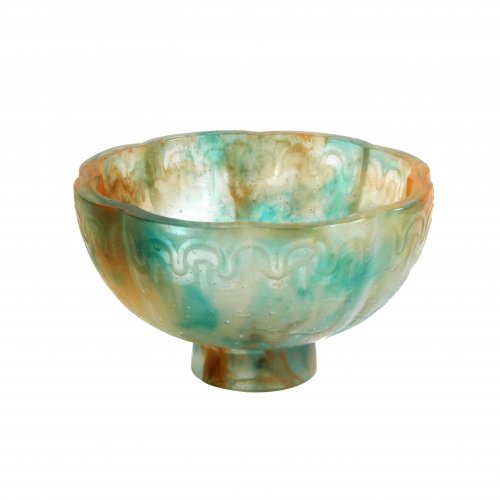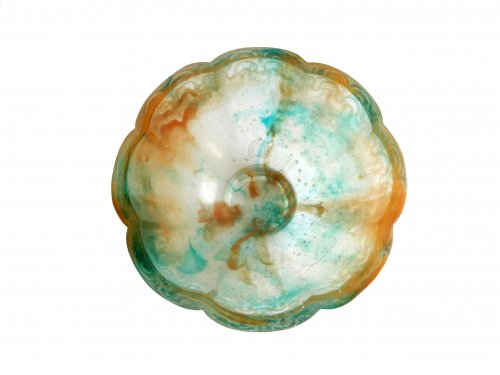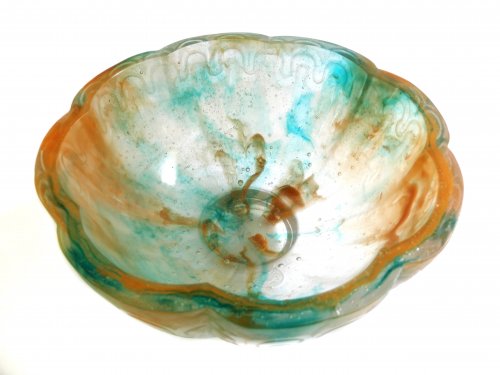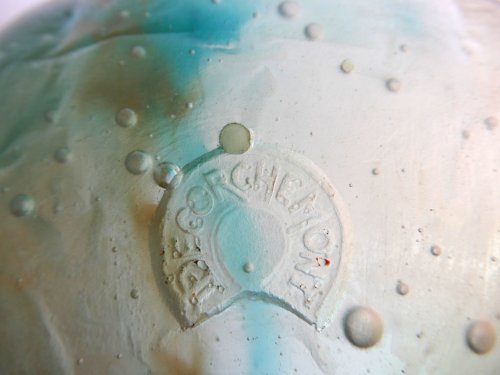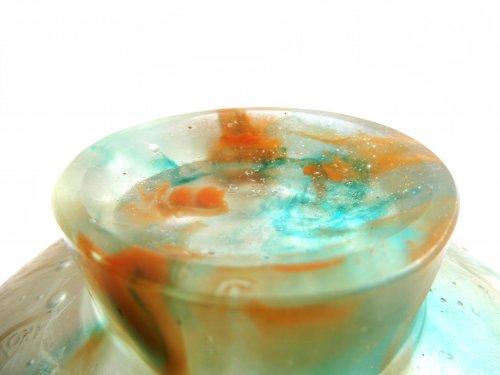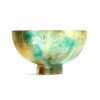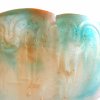François Emile Décorchemont (1880-1971) Coupe 'Bol à côtes frisé'
About this piece
Beautiful pâte de verre coupe by François Emile Décorchemont (France, 1880-1971)
This coupe has a scalloped edge and is decorated with a stylized frieze in relief. The coupe stands on a slender base.
The coupe was made in 1927 and 1928. Décorchemont only made 17 examples, in different colour combinations. So every coupe is unique.
This coupe with the beautiful colour of jade, veined with amber looks like a gemstone, yet it's pâte de verre. The coupe is signed with the well-known Décorchemond mark, in the form of a scallop, and it's numbered 'B306' on the bottom.
Décorchemont's glass is highly sought after and was sold at the time by the renowned Galerie of Géo Rouard in Paris. Today his work can be admired in various museums , like Musée D'Orsay in Paris.
Biography:
François-Emile Décorchemont (France, 1880-1997) was borne in an artistic family, both parents were artists. He went to the École Nationale des Arts Decoratifs (1896-1900) and besides he worked in the pottery studio of his parents. He painted and made ceramics.
In 1902 he became so inspired of the work in pâte de verre made by the glass artist Albert Dammouse, he started to experiment with this difficult material. In the meanwhile he exhibited at the Salon des Artistes Français with paintings and ceramics. At one point he exhibited also some vases of pâte de verre and directly received an honourable mention for them.
He decided only to make glass art made of pâte de verre, he experimented a lot to improve his technics. The material was so difficult to work with. A lot went wrong during the production. For instance the oven time took sometimes days and even weeks. But he went on and developed new techniques, for instant he used the cire perdue method. (lost wax method) Every item was polished, sometimes a motif was carved and because pâte de verre often has irregularities such as air bubbles, large air bubbles and other irregularities were sharpened.
During time, his forms changed, during the 1920's he used more geometric patterns and his decors were more simplified, fish, scarabs, dragonflies, leaf and flower motives and masques were often made in relief. He regularly incorporated masks in his designs, as a symbol of fear of war and the serenity of peace.
He won many prices and became a well known and respected artist. His work became very expensive.
He took part at the Exposition International Arts et Décoratifs in 1925. His work was exhibited in several pavilions, among them Jacques Ruhlmann's "Hotel d'un collectioneur". He also took part at big International exhibitions.
His gallery in Paris was Maison Géo (Galerie Rouard Paris) a modern art gallery who was specialized in the decorative arts from the major artists at that time, such as Jean Luce, Marinot, Goupy, Heiligenstein, Navarre, Sala, Mayodon and others.
In the 1930's he became very passionate making stained glass. After WWII he started working again with pâte de verre on a small scale, besides his stained glass projects. He died in 1971, 91 years old.
Literature:
- Veronique Ayroles; "François Décorchemont, Maître de la Pâte de verre, 1180-1971", Norma Éditions Paris, 2006, p.131, p. 141 en p. 273.
- Victor Arwas, 'Glass, Art Nouveau to Art Deco', Academy Editions London 1987, p.90 t/m 94 en 154.
- Collection Liebmann - Christies New York, 9 en 10 december 1994, p.154.
- Philippe Olland; 'Dictionnaire des Maîtres Verriers de l'Art Nouveau á l'Art Déco Marques & signatures, Éditions Faton 2016, p. 103 t/m 105.
Condition
Uitstekend
Material:
Pâte de verre
Measurements:
Height: 10 cm
(3,94")
Neck diameter: 17 cm
(6,69")
Year:
1927-1928
Period:
1927-1928
Origin:
France
Artist / atelier:
François Emile Décorchemont,
